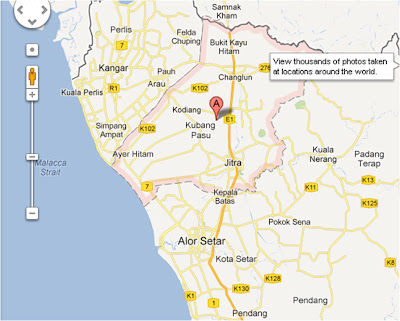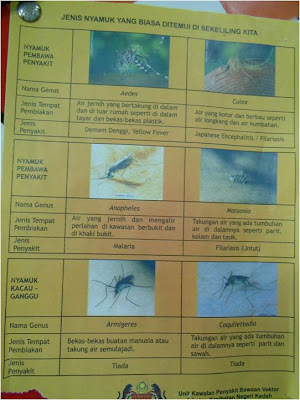AIMST University
Sometimes we always think that it is easy to get a van to pick up 14 number of students to the location we want excluding lecturer but don't you think it will be uncomfortable to be inside the van for almost 90minutes (90 to 100k/h) ? The challenge here is, we have to figure out the way to solve this problem together with the van driver. With that, the van driver promises us for a bigger van that able to allocate maximum 15 numbers of people. After all the discussion we have gone through,we have finally solved our problem and the journey to the District Health Office, Jitra, Kubang Pasu, Kedah has just begun with excitement and curiosity.
It look so much comfortable in this van
On the first day on traveling, we took almost 150minutes to reach our destination. The reason we took so long because we had lost the thread until we went to Chang Lun (almost to Thailand) and made a U-Turn from there back to Jitra Utara and eventually we found out the exact location we wanted.
Label "A" : Kubang Pasu
Kubang Pasu is located in Jitra, Kedah and it is surrounded by Kangar (Perlis), Alor Setar (Kedah) and Thailand. Below are the boundaries:
North : Thailand
East : District Padang Terap
West : Perlis State & Malacca Strait
South : Distric Kota Setar
The area is approximately 94,596 hektar (945.971km2). It consists of 21 sub-district (mukim) under the management of District Health Office, Kubang Pasu. The estimated local population is 167, 956 which can be broken down into different groups of age as in the pie chart shows below:
Health Services in Kubang Pasu
1. District Health Office (Pejabat Kesihatan Daerah) ------------- 1
2. Health Care Centre (Klinik Kesihatan) ------------------------- 8
3. School Health Team (Pasukan Kesihatan Sekolah) ------------- 1
4. Klinik Desa (Rural Clinic) ------------------------------------ 26
5. Hospital ------------------------------------------------------- 1
6. Pengamal Perubatan Swasta (Private Medical Practitioners)- 28
* The numbers show the quantity of building in Kubang Pasu area.
Clinic Health Care Center Around the Kubang Pasu
Finally, our arrival to the District Health Office (DHO) where our discussions take place in the meeting room of this building. Inside the meeting room, we are divided ourselves into 4 groups (each 4,4,3,3 which come into a total of 14 students). Among each group, we are assigned to find out the scopes and the purposes of our learning in DHO throughout our posting. Here are what we did on the first day. Let's begun...
District Health Office, Kubang Pasu, Jitra, Kedah
In District Health Office (DHO)
1. Introduction regarding the organization of the management by KPPKP Abdul Rahman
Organization Chart
Pembangunan Kesihatan Keluarga ------------------------------ Family Health Center
Bahagian Kawalan Penyakit dan Kesihatan Persekitaran - Disease & Environmental Control Center
Promosi Kesihatan -------------------------------------------------- Health Promotion
Pengurusan ----------------------------------------------------------- Management
We are concentrating on the Disease Control on the first day
Organization Chart of Vector-Born Disease Control Unit
Abbreviation:
PKD - Pegawai Kesihatan Daerah (District Health Officer)
KPPKP - Ketua Penolong Pegawai Kesihatan Persekitaran
(Assistant Chief Environmental Health Officer)
PPKPK - Penolong Pegawai Kesihatan Persekitaran Kanan
(Assistant Senior Environmental Health Officer)
PPKP - Penolong Pegawai Kesihatan Persekitaran (Assistant Environmental Health Officer)
KJK- Ketua Jururawat Kesihatan (Head Nurse Health)
PKA - Pembantu Kesihatan Awam (Public Health Officer)
PPKP
(Environmental Health Assistant)
– Supervision
and registration of PKA
– Registration of cases reported into government database
– Statistical
analysis of vector-borne diseases
– Monitoring
the programme in the community for vector-borne diseases prevention
– Investigation
of the cases reported
PKA
(Public Health Officer)
– Carry
out the preventive action in elimination of the vectors
– Involves
in vector-borne diseases prevention programme
– Spot
check and time-to-time monitoring on area allocated
– Collecting
the samples for investigation
Both PKA & PPKP:
– Issue
a compound
– Monitor the
progression & effectiveness of vector-borne diseases control programme
2. Vector born control by PPKP Yusnita (Dengue & Malaria)
PPKP Yusnita gave her briefing to us on the vector born diseases especially dengue and malaria. Besides that, she told us the duty of PPKP and what they did in a case of dengue is reported. This was what we have learned during the first day.
- Briefing on vector born disease such as dengue and malaria
- The role of PPKP in District Health Office
- E-Notification on cases to be reported
- Control of vectors
- Microscopic view of larva and how to differentiate Aedes Aegypti and Aedes Albopictus
- Statistic of dengue cases in Kubang Pasu
Vector Born Disease Unit
E-notification Dengue Control Unit Notification from the Government Hospital (GH).
This is done when a case of dengue is reported. Here's the steps :
When a case is reported, the doctor from the hospital or clinic must fill in the form below
Health 1 Form
This form will be sent to AMBRO of the Hospital. The AMBRO will key in the data in the e-notification and this must be done within 24 hours from the case when it is reported. Otherwise, the District Health Officer (DHO) has the right to give a compound to the doctor for RM500. Next, the PPKP who work in DHO will receive the data either via the e-notification or phone call from the AMBRO. Then, the DHO will register the e-notification for further investigations. The investigations are:
• Tracing
“movement” of the patient, 14 days prior to the onset of the symptoms.
• If
patient travel to other district or state within 14 days, PPKP will notify the
DHO in the areas involved.
• Investigation
will be done in all areas that are suspected to be the origin of infection.
• In
case, the larva of mosquitoes are found either in index case’s home or other houses
in coverage range,
the sample will be taken and preserved in 70% ethanol in laboratory.
• Spesies of the larva will be identified. Fine for
the house owner in case positive.
• Fogging
action is taken once the sources of infection are identified, mostly during dusk/sunset
time.
• Usually
done by 2 PKA and once a while, it is supervised by PPKP
If the investigations have done with positive report of dengue hot spot area (case confirm), PKD will be informed to confirm the case and PKPP will register the case in the e-notification (this registration is only happened when the case is confirmed by the PKD). The data registered by the PKPP will be transferred to e-dengue automatically. In the meanwhile, action will be taken to control the spread of the disease.
Action to be taken will be fogging at the coverage up to 200m range from the affected place. Fogging will be done only twice, one after the registration of case by PKPP and the another one after 7 to 8 days. If no case of dengue is reported, then the case will be closed. Otherwise, the steps will be repeated.
Notification of Dengue from private hospital isn't much different from government hospital. When a case is reported and confirmed by the doctor, the doctor will fill up the "Health 1 Form" that has shown above and will be directly sent to DHO within 24 hours rather than to the AMBRO of the Hospital. The other remaining steps are the same as from the government hospital.
During the discussion, PPKP Yusnita shows us the microscopic view of larva that preserved with 70% of ethanol in the bottles.
 |
| Bottles containing Larva |
 |
| Larva is preserved inside the bottle with 70% ethanol |
 |
| Microscopic View of Larva |
In addition, she also tell us the differences between both Aedes mosquitoes and some other pictures that are posted below.
 |
| Difference between Aedes Aegypti & Aedes Albopictus |
 |
| Differences between The Types of Mosquito |
 |
| Anatomy of Larva Types of Mosquito in Housing Area |
Dengue Outbreak
• More
than 2 cases in the same control, which means within 200m radius in 14
days after
the first case detected.
• The
investigation and fogging action will be carried out additional 50m
radius in addition
to 200m away from the point of origin until no new cases
detected.
• Coverage
will further extend by 50m each time if there are still new cases reported
within
same locality.
• From
pass experience, maximum of 450m radius had extended.
Suspect airport as source of infection
• Before
fogging is done, investigation will be carried out. A "Ovi-trap" is used to control aedes
mosquito population. After 3 days, the ovi-trap will be collected for the calculation of Aedes
Index (AI).
• Aedes Index (AI) :
Premise of positive case x 100%
Total Premise
• Indication
of fogging : Aedes Index
> 0
*An ovitrap is a device which consists of a black cylinder with a piece of cardboard. This device is used to control the aedes mosquito population. It can monitor, control and detect aedes mosquito populations thus acting as an early warning signal to preempt any impending dengue outbreaks)
 |
| Ovi-trap |
 |
| Level of Trap |
Preventive Measures
- Aedes Index
- Campaign
- COMBI
- Law Enforcement
- Gotong-royong
In General, to high light what we have gone through during the first day:
1. The duty of the people in DHO and understand the organization chart
2. How the system of e-notification works
3. The types of mosquito and how to differenciate from each other
4. How to control the vector born disease from becoming an outbreak.
5. Calculation of Aedes Index from "Ovi-Trap"
















Can you tell me a detail about the different between aegpti and albopitus
ReplyDelete